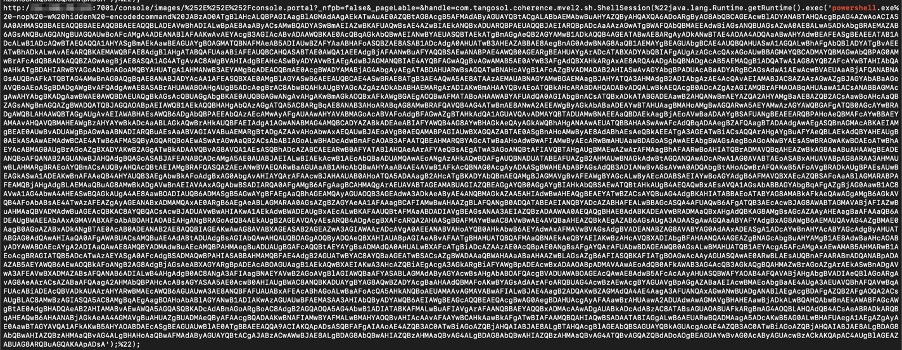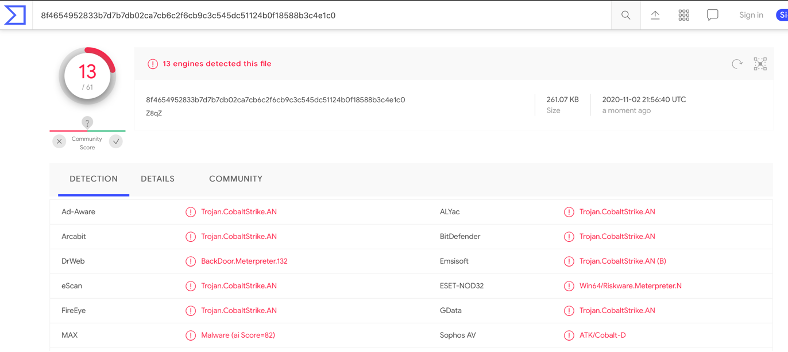Attackers Exploiting WebLogic Servers via CVE-2020-14882 to install Cobalt Strike
Starting late last week, we observed a large number of scans against our WebLogic honeypots to detect if they are vulnerable to CVE-2020-14882. CVE-2020-14882 was patched about two weeks ago as part of Oracle's quarterly critical patch update. In addition to scans simply enumerating vulnerable servers, we saw a small number of scans starting on Friday (Oct. 30th) attempting to install crypto-mining tools [1].
On Friday, Oracle amended its patch for CVE-2020-14882 [2]. A new variation of the vulnerability (CVE-2020-14750) can be used to exploit WebLogic servers with a trivial modification of the exploit code.
Last Saturday we started seeing a campaign using a chain of Powershell obfuscated scripts to download a Cobalt Strike payload. According to Cisco Talos Q4 2020 CTIR report, 66% of all ransomware attacks this quarter involved the use of Cobalt Strike [3]. Thus, as expected, there is a high probability ransomware gang included CVE-2020-14882 exploit in their arsenal.
The attack, as seen in Figure 1, exploits the vulnerability to execute a PowerShell payload base64-encoded.

Figure 1 - Payload delivery
Decoding the base64 content, we can find the following code. As seen, there is another encoding layer using base64 and gzip compression. I usually make some adjustments to the original malicious script to make it save the decoded content to a file. So, replacing “IEX” by “$content =” and appending the script with “$content |out-file -filepath decoded_script.ps1” is enough to accomplish this result for this case.

Figure 2 - First stage decoding
Part of the resulting code is shown in Figure 3. Notice that there is another protected code. There is a loop decrypting each byte of the code using an XOR function with the byte 0x35.

Figure 3 - Second stage decoding
The result of this operation is a shellcode to download and execute a Cobalt Strike payload hosted at http://185[.]205.210.179:4321/Z8qZ.

Figure 4 - Cobalt Strike payload download
Submitting the binary to VirusTotal, we had the following result:
 ]
]
Figure 5 - Cobalt Strike payload submitted to Virus Total
Running the malicious scripts in a controlled environment, it was possible to see connections established from time to time with the C2 at http://185[.]205.210.179/en_US/all.js.
References
[1] https://isc.sans.edu/forums/diary/PATCH+NOW+CVE202014882+Weblogic+Actively+Exploited+Against+Honeypots/26734/
[2] https://www.oracle.com/security-alerts/alert-cve-2020-14750.html#AppendixFMWl
[3] https://blog.talosintelligence.com/2020/09/CTIR-quarterly-trends-Q4-2020.html
IOCs:
Network:
45[.]134.26.174
http://185[.]205.210.179:4321/Z8qZ
http://185[.]205.210.179/en_US/all.js
Files:
Z8qZ:
8ca0251bc340fc207e6f832eb6165b8d (MD5)
8f4654952833b7d7b7db02ca7cb6c2f6cb9c3c545dc51124b0f18588b3c4e1c0 (SHA256)
The malicious requests are available at https://isc.sans.edu/WebLogicPS.log.zip
--
Renato Marinho
Morphus Labs| LinkedIn|Twitter


Comments